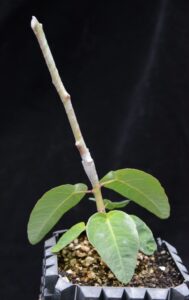Propagation at the King’s Park and Botanic Gardens
By Amanda Shade
The Kings Park and Botanic Garden nursery was established in 1962, several years prior to the opening of the Western Australian Botanic Garden (WABG). We grow roughly 50-60,000 plants annually for display in our many differently-themed collections within the WABG and wider parkland areas. The plants are used for restoration and rehabilitation programs in our managed remnant bushland, for tree replacement programs, and for conservation programs managed by other WA state government departments.
We are slightly different from commercial and other production nurseries in the sense that we only really have one ‘client’, that being Kings Park. We are still a primary producer, but our programs are very much dictated by the requirements of our state botanic garden, and our parkland displays and natural area revegetation/restoration programs – i.e., collections, conservation, and education as the driving influences.
Because of the nature of our activities, we have a defined main propagation season of spring and summer, when the majority of our production occurs. This is to allow for our ‘client’ requirements of stock size and age for optimal winter planting.

As a Botanic Garden nursery, we are uniquely placed to be able to see exactly where the stock we’ve produced is planted. Our location within the Botanic Garden means we are also able to monitor the establishment and performance of the plants once they leave the nursery. This often provides valuable data for us to enable constant improvements in our propagation programs and methods. It is also a really great stock garden for sourcing future propagation material.
We are also privileged to potentially have access to the flora from the entire state of WA, which at last count was close to 14,000 taxa. Rather than focus on a smaller number of species and grow large numbers of these, we do the opposite – we regularly deal with a large number of species (around three to four thousand) but tend to produce small quantities of each.
The diversity in both the species we work with, and the intended outcomes mean we inevitably come up against a range of different challenges. One way we have overcome some propagation and in-ground plant establishment challenges is to employ grafting techniques to produce more robust plants that can withstand the various soil and climatic issues we have here in Perth. While we can graft certain genera year-round using traditional wedge or cleft grafting methods, summer here in Perth means mummy grafting time.

We employ mummy grafting for a range of species but have found it particularly effective for Eucalyptus, Corymbia, and genera from dry, arid natural environments such as Verticordia and Eremophila. The Eucalyptus and Corymbia we choose to graft are generally taxa that are threatened in the wild, hybrids, or those with a particular growth or colour form that we are hoping to replicate. The Eremophila perform better on rootstock in our Perth soils as they are notoriously susceptible to nematodes, and the Verticordia species we graft are those we find can be a bit temperamental from other forms of propagation.
The mummy technique employs all the same principles as standard grafting, with the added step of removing all foliage from the scion and wrapping the entire scion and graft union in grafting tape (or in our case, laboratory film, which we find more suitable for our purposes). The other difference is the environment the completed grafts are placed into. Our standard grafted plants go into a high-humidity fogging facility that has regulated temperature, humidity levels, and water application via capillary matting. Our mummy grafts are placed into a very hot glasshouse, in an area we have modified to be able to reach temperatures of up to 60ºC on a hot Perth summer day. The rootstock is watered regularly to prevent drying, and we often see bud burst in a week in some of these species. While we don’t have scientific data to prove why this happens, anecdotally, the increased temperatures are likely leading to increased cell activity, allowing the cambium to fuse at a greater rate than it normally would.
Our success with this method is enabling us to produce greater numbers of previously harder-to-propagate species, meaning we can broaden our display collections for public appreciation and education, and can also vastly improve some of our conservation collections of threatened species. We hope to increase the suite of species we propagate in this way, so we are continually adding to our database of information which we are more than happy to share with others.
Amanda Shade
Manager Living Collections
Kings Park and Botanic Garden, Perth, WA
Article contributed for International Plant Propagators Society (IPPS)
Main photo: Corymbia ficifolia mummy graft onto Corymbia calophylla rootstock (Image: Dave Blumer)

